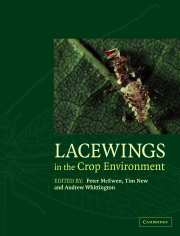Book contents
- Frontmatter
- Contents
- List of contributors
- Preface
- PART 1 Lacewing systematics and ecology
- PART 2 Lacewings in crops
- PART 3 Principles
- Introduction to Part 3
- CHAPTER 11 The use of lacewings in biological control
- CHAPTER 12 Mass-rearing, release techniques, and augmentation
- CHAPTER 13 Features of the nutrition of Chrysopidae larvae and larval artificial diets
- CHAPTER 14 Ecological studies of released lacewings in crops
- CHAPTER 15 Sampling and studying lacewings in crops
- CHAPTER 16 Interactions with plant management strategies
- CHAPTER 17 Lacewings, biological control, and conservation
- PART 4 Case studies
- PART 5 Conclusion
- Taxonomic index
- General index
CHAPTER 16 - Interactions with plant management strategies
Published online by Cambridge University Press: 04 May 2010
- Frontmatter
- Contents
- List of contributors
- Preface
- PART 1 Lacewing systematics and ecology
- PART 2 Lacewings in crops
- PART 3 Principles
- Introduction to Part 3
- CHAPTER 11 The use of lacewings in biological control
- CHAPTER 12 Mass-rearing, release techniques, and augmentation
- CHAPTER 13 Features of the nutrition of Chrysopidae larvae and larval artificial diets
- CHAPTER 14 Ecological studies of released lacewings in crops
- CHAPTER 15 Sampling and studying lacewings in crops
- CHAPTER 16 Interactions with plant management strategies
- CHAPTER 17 Lacewings, biological control, and conservation
- PART 4 Case studies
- PART 5 Conclusion
- Taxonomic index
- General index
Summary
EFFECTS OF PESTICIDES
Introduction
In the last 30 years investigations into side-effects of pesticides on beneficial organisms have gained more and more importance. The increase in knowledge is the basis for reducing the undesirable effects of pesticide applications, which among others, is an important principle of integrated production (Cross & Dickler, 1994). Whereas in former years companies presented data on side-effects of a pesticide on a voluntary basis to the authorities for the registration procedure, in 1986 this became obligatory in Germany (Anon., 1986; Brasse, 1990) and recently in all European countries, as regulated by the Council Directive 91/414/EEC. Factors to be considered when studying side-effects were published by Franz (1974). The IOBC/WPRS working group ‘Pesticides and Beneficial Organisms’, founded in 1974, has contributed considerably to research of side-effects caused by pesticides. The group is working (in close co-operation with registration authorities, EPPO) on the development, improvement, and validation of test methods (laboratory, semi-field, and field) and on rearing methods, and it carries out joint testing programmes to investigate the impact of pesticides on about 30 beneficial organisms (Hassan et al., 1983, 1985, 1987, 1988, 1991, 1994; Hassan, 1988, 1989, 1992, 1994; Samsøe-Petersen, 1989; Vogt, 1994; Sterk et al., 1999). Comprehensive data on research findings focusing on the interaction of pesticides with entomophagous arthropods have been published by Croft (1990).
- Type
- Chapter
- Information
- Lacewings in the Crop Environment , pp. 357 - 379Publisher: Cambridge University PressPrint publication year: 2001
- 6
- Cited by



